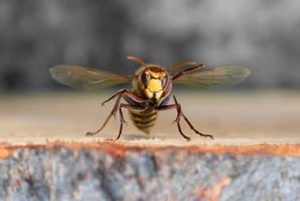It’s time once again to add a page to the chronicle of Russell’s Pest Control Halloween blogs. On some occasions, we’ve discussed local pests that are particularly creepy and alarming. Last year, we examined a frightful fungus that preys on ants. This year, we’re again going to travel far from home to have a look at a particularly terrifying little beast.
Perhaps you’ve heard talk of aggressive, predatory hornets in East Asia that are wreaking havoc on some cities there. These little beasties, whose common name is simply the Asian giant hornet, claim an average of 30-40 lives per year in Asia. In 2013, however, they exploded into public notice when they started attacking cities in China. More than 1500 people have been injured after encounters with these horrific hornets, and experts are scrambling to determine what has caused the increase in aggression (some reports are saying that the giant hornets may be attempting to reassert their dominance over threatened territory, but there are several theories out there). If this isn’t like the plot of some terrifying, modern Alfred Hitchcock flick, then I don’t know what is.
The average giant hornet in these large colonies is about two inches long, but those are just the every-day citizens. The queens (pictured here) are about the same length as the palm of an adult human’s hand. The drones have stingers that are about ¼ inch in length, and they pack a particularly potent venom. Those injured by the hornets compare the sting to a hot nail or a bullet, and as few as ten stings can be hazardous to a human, even if the person is not allergic to the venom.
Even before their sudden spike in aggression, these hornets were a major problem in the Asian agricultural economy. Giant hornets require protein in their larval stage, so the drones will often invade honey bee hives to steal bee larva to feed to their own young. Because the hornets have such a size advantage, a few invaders can completely wipe out a large honey bee hive in a shockingly short amount of time, and Asian bee keepers have faced the devastating effects of these gruesome giants. In case you were wondering, the hornets use their oversized jaws to kill the bees by decapitation. So, that’s just great.
When you’re fighting a zombie, a shotgun is supposed to be the weapon of choice. Werewolf slayers favor silver bullets, and vampire hunters usually carry around a trusty stake. When you’re fighting killer giant hornets…well, the list of appropriate weapons is fairly short. Pest experts were rushed to the area to try to eliminate the large hives as quickly and safely as possible. Those who aren’t willing to wait are resorting to gasoline-fueled fireballs, which is rarely a good idea but does, again, sound like something out of a movie.
And, just in case you needed a bit more creepy news to really set the Halloween tone, I should also mention that at least one country in Western Europe has reported seeing these giant hornets. We have discussed the dangers of introducing pests into new ecosystems before, so we’ll have to wait and see if these hornets can survive outside of their native environments.
Happy Halloween!
A Halloween Fright: Giant Hornets in Knoxville TN
Serving East Tennessee since 1971


